Device Profile: Mesh Dynamics Module access point
Mar 4, 2005 — by LinuxDevices Staff — from the LinuxDevices Archive — 5 viewsA startup in Santa Clara, Calif. is shipping a Linux-based mesh router aimed at VoIP and video. The Mesh Dynamics Module uses multiple radios — along with custom real-time Linux extensions — to create a duplexing backhaul network said to improve bandwidth more than 64 times over conventional mesh technology.
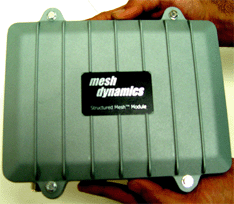
The Mesh Dynamics Module includes a weathertight case
Currently, the technology works well enough that LinuxDevices was able to interview Mesh Dynamics co-founder Francis Dacosta over a four-hop mesh VoIP network. Sound quality was on par with early cell phones, while latency was excellent — the conversation was truly full-duplex, supporting multiple interruptions for pointed questions.
According to Dacosta, normal, single-radio access points function in a half-duplex manner — that is, they must stop transmitting in order to receive, and vice versa, a limitation that reduces bandwidth by 50 percent for each hop in the mesh. Mesh Dynamics is attempting to solve this problem by dedicating separate radios to upstream and downstream traffic of a “backhaul” network that relays traffic between mesh nodes, thus simulating full-duplex operation.
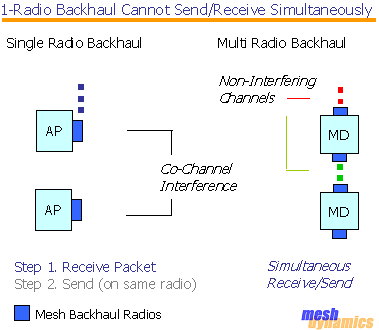
The Mesh Dynamics multi-radio backhaul simulates the full-duplex capabilities of a wired network switch stack
It sounds simple enough, but it turns out that using multiple radios creates a need for a real-time operating system that can satisfy the real-time constraints required by the distributed control system that manages the mesh network. The company began the project three years ago with the intention of using its own hard-real-time operating system. However, when the developers realized that Linux could “do most of the work,” as Dacosta put it, they simply wrote extensions to the Linux kernel to add real-time capabilities.
Asked how the kernel extension is licensed, Dacosta said, “We'd be happy to provide it to anyone once we get it working, although I'd question its value without a full development environment, which we probably will not offer.”
 A third radio in the Module serves as a dedicated service radio. If a fourth radio is added, it can be dedicated to the channel management software. Typically, the service radios use 802.11-b or -g radios, while the backhaul radios use separate 802.11a channels.
A third radio in the Module serves as a dedicated service radio. If a fourth radio is added, it can be dedicated to the channel management software. Typically, the service radios use 802.11-b or -g radios, while the backhaul radios use separate 802.11a channels.
Essentially, the multiple radios in Mesh Dynamics access points allow them to work more like network switches, Dacosta says. Switches are immune to the loss of bandwidth that usually affects mesh networks after multiple hops.
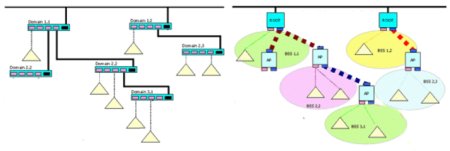
The architecture resembles that of cascading network switches
What's under the hood?
The Mesh Dynamics module is based on a custom single-board computer powered by an Intel XScale IXP425 processor. It has 128 MB of RAM, and 32 MB of SDRAM.
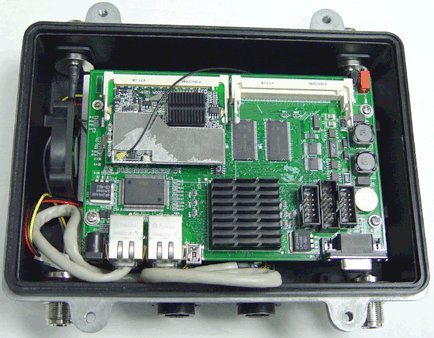
The Module with four mini-PCI slots; running Linux, of course
The board includes four Type-III mini-PCI slots, which can be populated by supported radios (currently 802.11a/b/g cards from Atheros). Four N-Female pigtails (antenna cables) for high gain antennas or power amplifiers are provided. However, administrators should take care when using high-gain radios to avoid the “hidden node” problem, in which the coverage area is so broad that clients remain ignorant of one another, and transmit simultaneously.
The board also includes two wired Ethernet ports, and two RS-232 serial ports. It requires 6-28 VDC, supplied through Ethernet (PoE), and draws 5-to-12 watts, depending on number of radios. The device measures 8 x 6 x 2 inches, and has a suggested operating temperature of 0 – 70 degrees Celsius.
The Mesh access points run a uClinux 2.4.22 implementation, which has a smaller footprint than standard Linux. The implementation includes the real-time extensions mentioned above, along with a VoIP concatenator, QoS packet classifier, and scanning and mesh control applications.
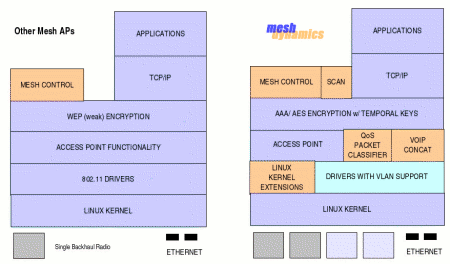
Comparing the Mesh Dynamics software stack (right) with that of competing mesh products
One unique feature of the implementation is the capability of compiling its own network applications during device configuration. After the radios have been installed, firmware is downloaded using tftp. The firmware then compiles its own networking applications after auto-detecting relevant MAC addresses, and reassigning them using addresses from Mesh Dynamics's own pool.
Dacosta sees big things for mesh networking, assuming problems associated with multi-hop bandwidth drop can be solved. He imagines a day when mobile computing devices will compete effectively alongside mobile phones in mesh-enabled metro areas.
Availability
The 3-radio Base Module is available now, priced at $2,900 without antennas. The company also sells network management software based on Eclipse, and a mesh network planning tool. Additionally, it offers OEM platform support.
This article was originally published on LinuxDevices.com and has been donated to the open source community by QuinStreet Inc. Please visit LinuxToday.com for up-to-date news and articles about Linux and open source.